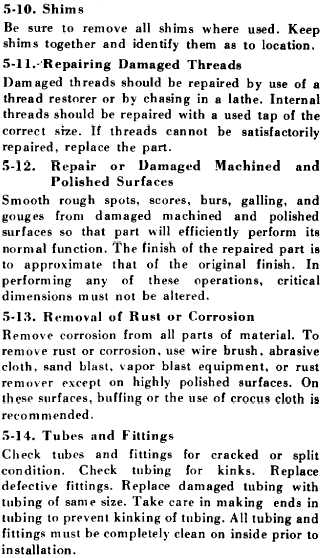|
| |
Table 5-1. Troubleshooting Chart -Continued
Malfunction
Probable Cause
c. Defective quench thermal ex-
pansion valve.
8. High suction pressure.
a. Defective thermal expansion valve.
b. Defective pressure regulator valve.
9. High head pressure.
a. Overcharge of refrigerant.
b. Condenser coil dirty.
c. Defective condenser fan motor.
d. Inoperative or improper ad-
justment of condenser louvers or
actuating mechanism.
e. Compressor defective.
f. Quench thermal expansion valve
defective.
Corrective Action
c. Replace valve ( para 5-29 ).
a. Replace valve (para 5-28).
b. Replace valve (para 5-31).
a. Discharge refrigerant as necessary
( para 6-3 ).
b. Clean coil.
c. Repair motor (para 6-8).
d. Adjust and clean as necessary.
Replace inoperative components
(para 5-20).
e. Replace defective compressor
(para 5-17).
f. Replace defective valve (para 5-
29).
Section III. GENERAL MAINTENANCE INSTRUCTIONS
5-6. General
This section contains general repair instructions
which would otherwise have to be repeated several
times.
5-7. Refrigeration System
a. Opening System. When the refrigeration
system must undergo maintenance that requires the
system to be opened for removal of parts, the
system must first be discharged and purged (para
6-3). After the repair has been made and all
soldering completed, the system must be charged
(para 6-31) and tested for leaks.
b. Removal of Parts. It may be necessary to
remove some tubing and fittings with a part that is
to be replaced. The tubing and fittings can then be
removed from the defective part and installed in the
new part. Care should be exercised in opening
joints- or resoldering to prevent damage to other
parts of the air conditioner.
c. Brazing. Braze copper to copper joints with
silver solder type 3, 4 or 6A specifications QQ-S-
561 and copper to brass or copper to steel with type
4 or 6A specifications QQ-S-561 per MIL-B-7883.
Solder melting point is 1160°F. All brazed or
solder joints shall be made with an atmosphere of
inert gas to prevent internal oxidation.
5-8. Insulation and Gaskets
Replace damaged insulation and gaskets. Cement
loose insulation.
5-9. Hardware
Replace any damaged screws, washers, lock
washers or nuts. Use screws of correct length to
hold parts securely. In some applications screws
that are too long may bottom before the head is
tight against part it is to hold or may cause damage
to the threads or other parts.
5-4
|

